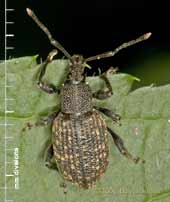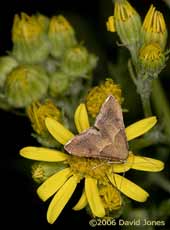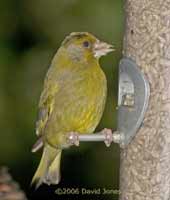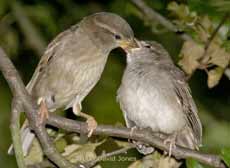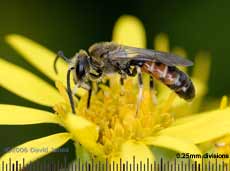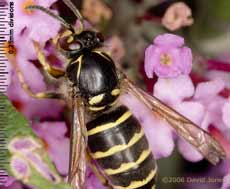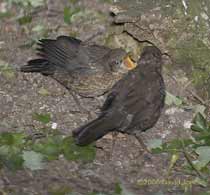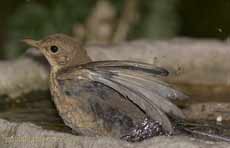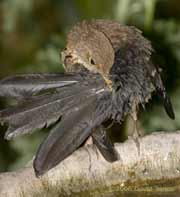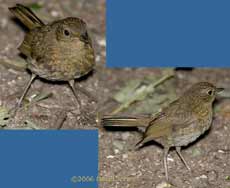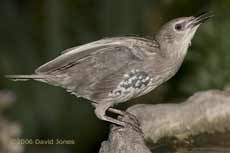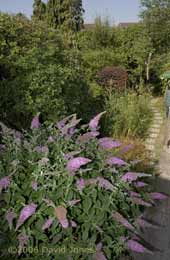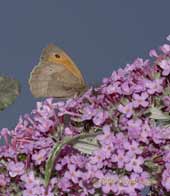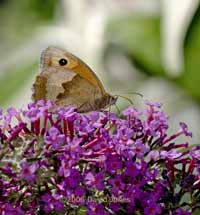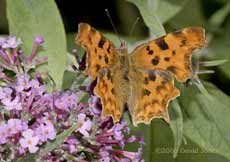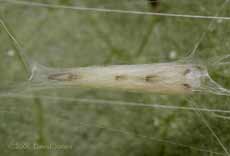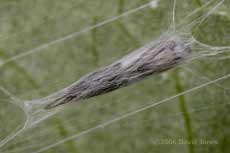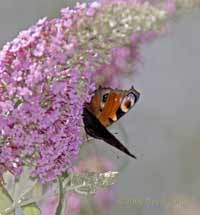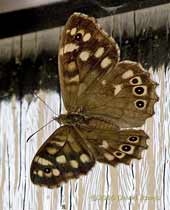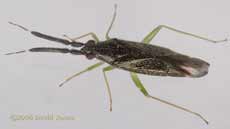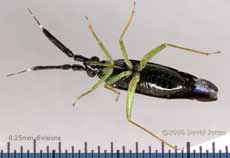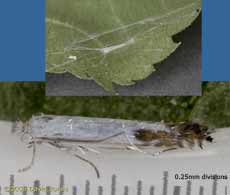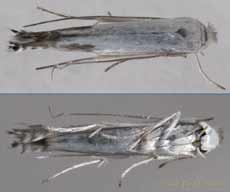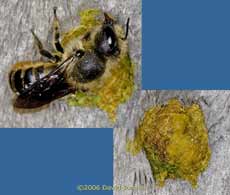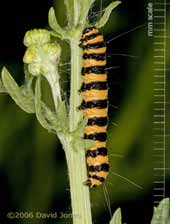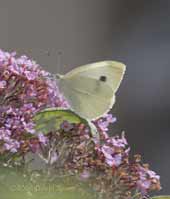Go to the last entry on this page .....Go to previous entry9 July - A thoroughly miserable start to the day with grey skies and drizzle. This continued through much of the morning before things improved gradually. This evening there isn't a cloud in the sky. Two pictures from last night -
First of all, what looks suspiciously like Otiorhyncus sulcatus, the Black Vine Weevil, a species regarded as a serious pest, its larvae attacking roots.
On the Ragwort the Cinnabar moth caterpillars are doing well, while the flowers are still slow to open - last night, this moth had found one of those flowers. I had hoped to find moths on the Buddleia, but there were none at the time I checked around 10.30pm.
This morning, the dull conditions were responsible, perhaps, for this Greenfinch coming to feed. I often hear their calls but rarely see them feeding here.
At last I managed to get a picture of a fledgling Sparrow being fed. This was one of a pair that spent ages together, calling for attention before mum turned up.
While it was still very damp outside I spotted an adult Robin in the shadow of the Hawthorn. It stayed away from the feeding area and seemed very nervous, but at least there is still one about - I haven't seen the young one in the last few days. 10 July - Another dull day, with drizzle in the afternoon. Today I took delivery of a new platform step-ladder to help with jobs like trimming the Hawthorn - my old step-ladder was too short for the job. It's very stable, and will prove quite useful for high-level photography in the garden. A a result of the step's arrival I spent much of the afternoon trimming a foot or so off the top of the Hawthorn, and I will need to finish the job tomorrow.
Before it became damp I decided to get a few photographs of visitors to the Ragwort flowers. 'Our small solitary bees were the main visitors,
However, this different solitary bee turned up. I wasn't able to get a dorsal view, but the red bands on its abdomen seem to match quite closely the mining bee Adrena florea, although I need to try to get more photographs to help confirm this. I shall watch out for it again tomorrow.
As the drizzle started, I headed back to the house, but then spotted this wasp on the Buddleia. I had the MP-E lens on the camera, and with no time to change it I had to get in close to take this image with the lens set to the same x1 magnification that I had used for the first two shots. The nearest match I can find for the wasp is Dolichovespula adulterina which is a cuckoo species in the nest of another wasp species, although they are not common.
15 July - A very warm, sunny day (25C) as the dry weather continues. I've been trying to get some jobs done around the garden over the last few days. I have taken some photographs, but haven't had the energy to sort them out until now!
I'll start on the 11th. While I haven't seen any more of the young Thrush that I saw at the beginning of the month, we are now getting frequent visits from this fledgling Blackbird, which has come out of hiding at the bottom of the garden.
Since I took that picture on the 11th, it has been spending more and more time foraging for itself, and bathing in the birdbath,
and it is quite happy to preen afterwards, with us sitting on the veranda just a couple of feet away.
Sometimes here at the same time is this juvenile Robin which, like the Blackbird, is extremely tolerant of our presence. It is just starting to get the first signs of a red breast. Today I saw an adult, which is very unusual at the moment.
Another youngster that is starting to gain adult plumage is this Starling, with the small patch of mottled plumage developing on its side.
The Buddleia is well into flower now. We have to pass it every time we head into the garden, and the aroma of honey is almost overpowering.
We have had only a few butterflies visiting it, which is a bit disappointing, and here are two that I managed to photograph yesterday. The first was this Meadow Brown which was very sensitive to any movement so I couldn't get very close to it.
This one, with bolder markings is, I think, a female.
Over the last few days I have seen several Comma butterflies here, including this one that stayed long enough for me to get a couple of shots. There have also been numerous Large Whites around, and a couple of Red Admirals which I didn't see land in the garden.
It looks as though the transition from caterpillar to moth is almost complete in the silk cradle on the Elder leaf. This picture, taken this morning, shows (I think) a light coloured moth with dark eyes (on the right) and three pairs of dark 'feet'. I will be checking it tonight, and then frequently over the next few days.
The other caterpillar that I photographed on the 7th July seems to be active still. Since I photographed it as it used silk to fold a leaf, that leaf has died and the caterpillar has gone on to bond two complete leaves together. I am keeping both this caterpillars and the pupa in a container, and the number of droppings that are appearing show that the caterpillar has not yet turned into a chrysalis.
Finally, we have had Ospreys flying over us over the last few days. Unfortunately they are not the feathered, but the metallic variety as Farnborough prepares for its air show next week.
16 July - It's getting warmer, with the temperature in the garden reaching 29C at 2.20pm. I'm having to take things easy today, but a couple of updates are needed.
First of all, another look at the moth in the cradle shows even more change since yesterday, suggesting that the transition must be almost complete.
The warm weather is helping with the butterfly count. Today we have had several visits by a Peacock butterfly, although it was reluctant to open up its wings when the camera pointed its way, and
this afternoon this Specked Wood flew into our kitchen. I'm still to get a photograph of a Large White, even though that is the species that visits most frequently. I've also seen a Brimstone go by (no chance of that breeding here as we have no Buckthorn plants here), a Red Admiral has been fluttering about during the afternoon, and I've caught sight of another small brown butterfly that I couldn't identify. I haven't seen any Holly Blue butterflies recently.
The leaf-cutter bees are more active now. This morning we saw, for the first time this year, one of them delivering pollen, and then cutting leaves to seal what must be the first cell in the tube. By the end of the afternoon the temperature had hit 30C, and with virtually no breeze, even with low humidity, it became quite uncomfortable away from a fan. Tomorrow is set to be hotter!
I often see these in the garden, often on the Ragwort, but they inevitably dash to the other side of the leaf when I point a camera at them.
This one spent a short period between two sheets of thin glass while I took these photographs. This second image shows that as well as its legs being green, so is its rostrum (its sucking mouth-piece). I believe it is Heterotoma planicornis, a predatory species, hunting other insects, although it will also feed on plants.
17 July - Today is going to be another hot one, with it 22C at 9.20am and likely to pass 32C this afternoon. Last night the 'hammock vigil' came to an end when this tiny moth, measuring barely 4mm in length, emerged from the silk cradle on the Elder leaf before 10pm. It looks as though it is the Apple Leaf Miner moth (Lyonetia clerkella). Thanks to Tim Norriss and Ian Thirlwell for their initial ID. The caterpillar created the 'hammock' on 7 July, and had started to pupate by the 8th.
Taken through glass, here are two more images to show top (dorsal) and bottom (ventral) views of it. Although the pictures do not really show it, the white scales had an almost pearl like effect when light shone on them. As Sheila has just said, it is amazing to think that such a small moth should have gone to such a feat of construction to prepare for its metamorphosis.
The forecasters were spot on, and it reached just over 32C this afternoon - in two days time it may approach 37C!!!! I'm afraid that we've been wilting already, and it seems that the heatwave is also having an effect on the garden birds. I put fresh water into the bird bath this morning (as normal) and I don't think it has been touched all day, which is a bit of a surprise. Yesterday I had to top it up several times as the Starlings especially took advantage of it. They haven't been here today, and neither have the Blackbirds or Blue Tits. Other than a small group of Sparrows, I have seen just one Goldfinch, and a Collared Dove is feeding as I write this.
The solitary and bumble bees, on the other hand, seem to have relished the high temperatures, and have been busy. I spotted this solitary bee sealing a hole that is tucked away behind a water butt. It seems to have used a pulp of chewed petals and a bit of leaf. I haven't seen similar seals at the other bee hotels this year.
I found a leaf-cutter bee investigating a length of porous garden hose. It hadn't started work so I decided to discourage it as the tube would hardly have been water-proof during the winter. There was also a social wasp scraping off wood to help the construction of its nest.
I thought I'd better include a Cinnabar Moth update. The caterpillars (a couple of dozen of them) vary greatly in size, and this is one of the largest at the moment, measuring around 25mm (1 inch) in length. I understand that they pupate after about five weeks, so as they hatched on 28 June, it will be another couple of weeks before they head for the ground to produce their pupae.
Today we saw a couple of Holly Blue Butterflies, and this Small White perched long enough for a couple of grabbed, and fuzzy images with an unsuitable lens. It seemed to jump from flower to flower in a way I don't think I've noticed before. I've still to get images of the Large Whites that are visiting us, and of the Red Admiral that I keep seeing at the bottom of the garden.
18 July - The heatwave goes up a notch, with the temperature passing 33C here today. Tomorrow the high could be as much as 37C, and the weather forecaster has just suggested that some places could reach 38C!!! Like yesterday, there have been few birds in evidence in the garden, although we did actually have (just) two Starlings come to bathe. With a bit of luck tomorrow, before mybitoftheplanet reaches its maximum temperature we will be somewhere in the West Country, if not already on the Lizard, heading for our caravan. It means that there will not be any diary entries for a while (length of absence undecided, as usual). I have had a bit of exercise, making sure that the ponds are full (we are allowed to use a hosepipe to do this, but it's buckets or watering cans for everything else), and that a few potted plants have been watered. As usual, my sons will be ensuring that none of the important plants die if the rains continue to keep away during our absence. I owe an apology to those people who had hoped to see the pictures from our last trip. Those pictures are going back with us, along with a copy of my diary (which I forgot to do last time), and I hope to get the holiday diary back up to date and ready to up-load as soon as I get home again. Click on the images to see larger versions - |
|
